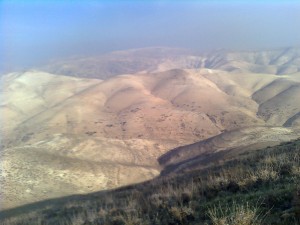“And he looked out onto the Yeshimon (wilderness)”
(Bamidbar / Numbers 21:20)
This weeks portion discusses Balaam’s unsuccessful cursing of the Children of Israel at the behest of King Balak. There is a scene where he is looking out onto the wilderness or ‘Yeshimon’ in hebrew.
The Bible mentions 4 types of arid terrain which are many times confused under the same heading ‘desert’, these are:
Midbar
Negev
Arava
Yeshimon
A Midbar, IS NOT a real desert. In hebrew, words have root letters the root letters connected to other words with the same root letters.. The family of root letters ‘d’ ‘b’ ‘r’ are to do with grazing or raising flocks. In a few places; in the book of Micah and Isaiah, the word ‘Dover’is used, meaning to graze cattle. Midbar is an a arid terrain which cannot sustain crops but can sustain flocks for part of the year. The picture above is Wadi Kelt in Midbar Yehuda; the Judean (for want of a better word) desert.
Negev means both South and desert its root letters are associated with being dry, Naguv means dried up. Negev is true desert, the area south of Beer Sheva is all desert.
Arava, means East and also is to do with mixing things. An Eruv is a mixture of things. The Arava area is a valley in the south of the Country which has a subterranean water supply. It is also a ‘mixture’ in terms of being the place where the red mountains of Moab (modern day Jordan) meet the land of Israel.
Yeshimon is just a waste. Its root letters ‘sh’ and ‘m’ appear in the word ‘shamam’ meaning waste. In fact it is used in the first usage of the phrase ‘howling waste’ in Deuteronomy 32:10. In our portion in represents what Balak and Balam wished to find; a wasted nation devoid of hope and purpose, instead they found a great nation and were forced to bless them.

